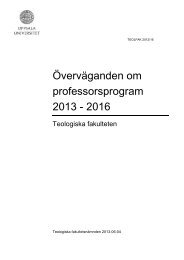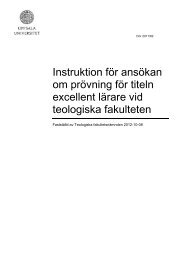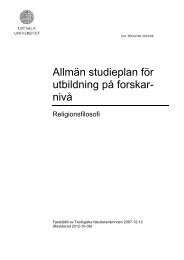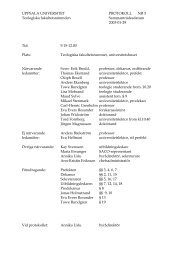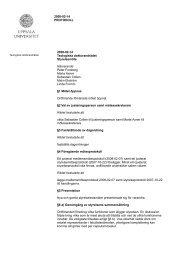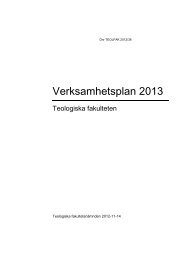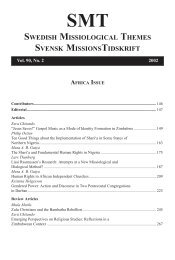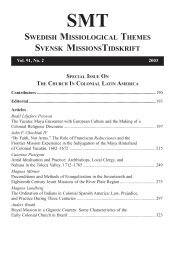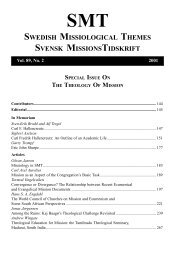SWEDISH MISSIOLOGICAL THEMES SVENSK MISSIONSTIDSKRIFT
SWEDISH MISSIOLOGICAL THEMES SVENSK MISSIONSTIDSKRIFT
SWEDISH MISSIOLOGICAL THEMES SVENSK MISSIONSTIDSKRIFT
You also want an ePaper? Increase the reach of your titles
YUMPU automatically turns print PDFs into web optimized ePapers that Google loves.
488 Tormod Engelsviken<br />
mission today, is the “power encounter”, which primarily is about spiritual<br />
power where miracles or other challenges of the spiritual forces of the pre-<br />
Christian religion led many to lose faith in the old religion and turn to Christ.<br />
There was also another Catholic mission during the Middle Ages which was<br />
directed towards heretics, Jews and Muslims. 16 This mission was also carried<br />
out mainly by monks or priests. Islam surrounded Christian Europe both in<br />
the east and southwest and represented both a political and military threat.<br />
The crusades cannot be seen as missionary initiatives, and the crusaders were<br />
not missionaries. Even after the crusades the Christian Europe had to defend<br />
itself against the Muslim onslaught in Spain and on the Balkans.<br />
The spiritual defence and the missionary initiatives of the medieval church<br />
in Europe during the thirteenth and fourteenth century were mainly the<br />
result of the work of the new orders, the Franciscans and Dominicans. It is<br />
worth noticing that this mission came out of a spiritual renewal which also<br />
was accompanied by a missional spirituality and a consciousness of<br />
community. The missionary method was not the use force but was spiritual<br />
and intellectual: a literal understanding of the words of the gospel about<br />
the apostolic life led to a life in poverty where preaching and teaching<br />
stood in the forefront. The “preaching brothers” who followed Dominicus,<br />
were not tied to monasteries, but emphasised studies not least in connection<br />
with the newly established universities. Already in the year 1228, eight<br />
years after the first general chapter which is seen as the founding of the<br />
order, there were 60 houses established all over Europe and especially at<br />
the borders of Christendom. The Dominicans wished to win Jews, Muslims<br />
and Mongols through a preaching and a theology that were philosophically<br />
and spiritually superior.<br />
The most well known Dominican is of course Thomas Aquinas whose<br />
theology has a clear missionary purpose when he with arguments of reason<br />
seeks to convince the Gentiles of the truth of Christianity. One of his two<br />
major works, Summa contra Gentiles, was a textbook for missionaries filled<br />
with arguments to be used in dialogue with non-Christians, especially<br />
Muslims. Although Thomas himself did not go out as a missionary, he has<br />
nevertheless exercised a great influence as a mission theologian on Catholic<br />
mission both in terms of theory and practice.<br />
16 Skarsaune 1994:105-109



